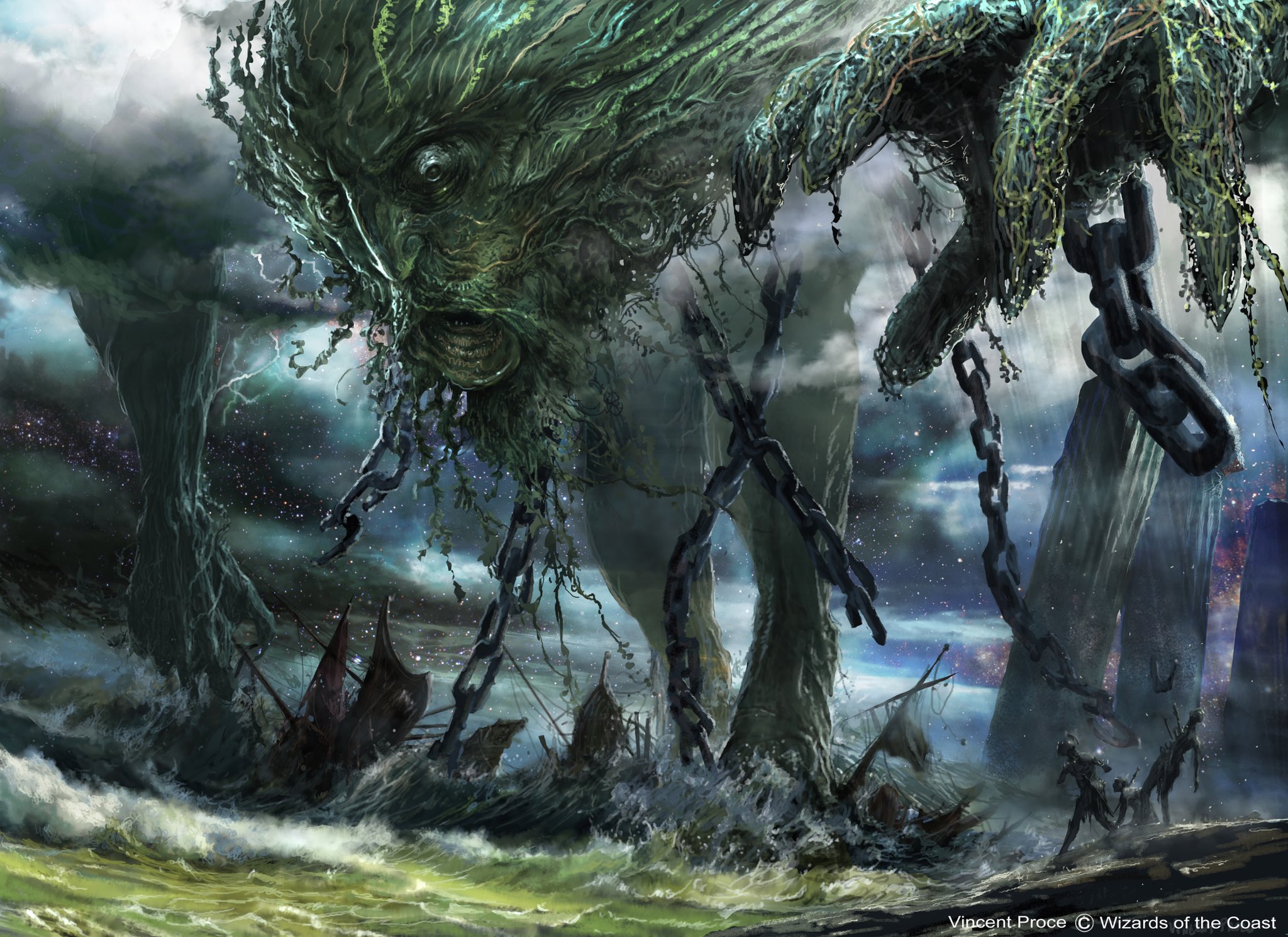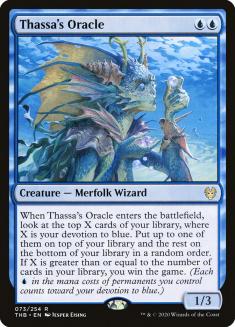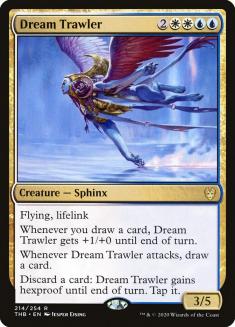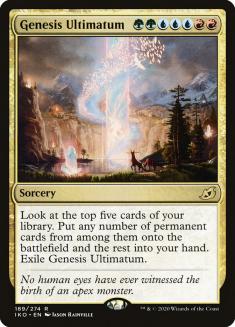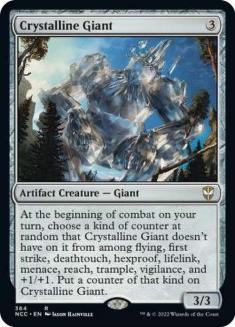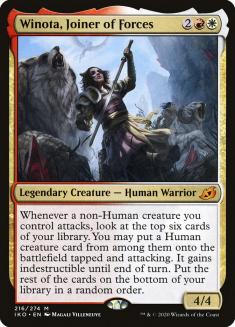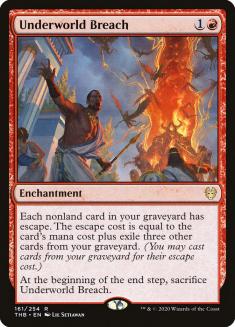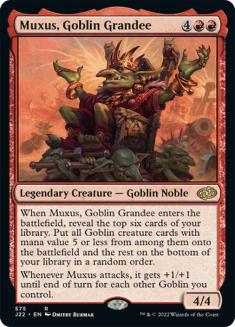Oh man. It’s finally here. New Year’s Eve of 2020, the worst year of my life. I can only assume that this year has also been the worst year of many of your lives as well, so allow me to brighten your last day in this horrible year.
Before we begin, I’d like to say that most of my enjoyment in Magic comes from seeing my friends, playing tournaments for big prizes, and providing commentary for high-profile tournaments. Without “The Gathering,” it gets harder to see the Magic. Mistakes like Oko, Thief of Crowns aren’t necessarily better or worse than some of the stuff we’ve seen printed in 2020, but it’s much easier to forgive these mistakes when all the good stuff comes along with it.
From the companion mechanic to some ridiculously pushed story-based legends, this Top 8 list will go over my least-favorite cards printed this year, why they got printed, and how we can avoid these mistakes in the future. It’s not easy to design Magic cards, so I don’t want the takeaway here to be anything inflammatory. I would very much like for these kinds of mistakes to stop happening in the future, but we all know they gotta sell packs.
Without further ado, let’s get big mad about Magic cards printed in 2020!
Honorable Mention — Thassa’s Oracle
This card singlehandedly ruined Pioneer for me. Dimir Inverter clamped hard onto the format and didn’t let go until they banned Inverter of Truth back in August. It kept showing up in the strangest of places! It became the default win condition for any deck that tried to mill itself out.
The biggest downside for Thassa’s Oracle is that it didn’t really make sense how you lost when you ended up losing to it. Inverter plus Oracle couldn’t be stopped by removal spells even though both were creatures. It was the definition of anticlimactic.
The actual design of the card is really cool. Often, a problematic card is only problematic because of one added line of text or one small tweak. Thassa’s Oracle would have been a great uncommon without that last line of text about winning the game. Instead, it’s one of my least-favorite cards, and this is coming from someone who loves Frostburn Weird.
9th (on breakers) — Dream Trawler
Dream Trawler is one of those cards that gets heinously overshadowed by more powerful cards but is an actual nightmare scenario for most aggressive strategies. It’s a brainless win condition. It just attacks, never dies, never runs out of juice, and puts you at an unreachably high life total. Every single part of the card is frustrating, as it leads to games that stop being games.
This is one of the few cards of its kind that can protect itself without spending mana. Blue decks are infamous for having extra dead cards in hand, so turning those into fodder for Dream Trawler is painless. Whoever designed this card clearly never played Theros Block Constructed, as Prognostic Sphinx was one of the more obnoxious win conditions I’ve ever played with or against. Adding lifelink to it would only further my hatred of it.
There’s rarely any question on what is a more important resource. Discarding a card is far superior to losing your five- or six-mana creature. This type of ability should be reserved for cheaper threats like Seasoned Hallowblade. Giving someone the illusion of choice, or a choice where the answer is very obvious, doesn’t encourage dynamic gameplay and results in repeating play patterns.
You might as well just give it protection from red and black.
8. Genesis Ultimatum
As a Temur aficionado, Genesis Ultimatum should’ve been right up my alley. For all its many faults, Genesis Ultimatum actually hits pretty hard on the “feel-good” scale for the person casting it. I’d say it even creates some pretty hype moments of excitement where anything could happen! The nail in the coffin is that, regardless of what happens on said Genesis Ultimatum, the person casting it almost always wins, and here’s why:
- You get to keep the non-permanents.
There’s no pressure. There’s only spectacle for the sake of spectacle. There is no world where Genesis Ultimatum can miss except for putting enough permanents onto the battlefield to survive. If the game is at parity or you’re ahead, casting Genesis Ultimatum will almost always seal the deal. The same is not true for any of the other Ultimatums.
- Seven mana is absurdly easy to generate.
With so many efficient ramp effects in Standard, seven mana was no longer a big deal. Lotus Cobra and friends allowed you to get seven mana on the third or fourth turn. A single Genesis Ultimatum could generate enough mana to cast even more stuff afterwards. When cast, it was always a calamity. The worst Genesis Ultimatum was still good enough.
- The (RR) felt tacked on.
The card could very easily have been just green and blue. The fact that red is thrown into the mix just didn’t hit for me. If the last few years have taught me anything, it’s that green and blue draw cards and put permanents onto the battlefield.
Overall, Genesis Ultimatum just didn’t do it for me. I like Temur cards that enhance or mold gameplay to your choosing. Genesis Ultimatum is just a big ol’ hammer that wins just about any fair game where it’s cast. The Temur Clan would not embrace Genesis Ultimatum as a spell of their own.
7. Crystalline Giant
Never in all my years of playing Magic have I seen a card so obnoxiously worded. This card was explicitly designed to be played on Magic Arena. Here’s how you go about determining the ability granted to Crystalline Giant each game if played in real life:
- Acquire D10.
- Assign each of the ten abilities to a number.
- Roll D10. Pick the ability that corresponds with the generated number.
- If that ability has been chosen before, re-roll.
- Make little pieces of paper with each ability written on it.
Or…
- Have a bag full of scraps that represent each ability and have your opponent grab one at random each turn. This should in no way be sanctionable by a Magic judge.
And it sucks! It’s not even good! How do you create such a boring card that requires so much effort to represent!?
6. Winota, Joiner of Forces
I love the idea behind this card. A Human leader joining forces with other clans to defeat a common enemy is a well-explored trope. Finding a way to accurately represent that iconic act is difficult, but Winota, Joiner of Forces nearly pulled it off. Again, we have an extra line of text (or three) that completely ruins the play experience.
- No limiting factor to casting cost or size.
This part makes it feel less Boros and more like a combo card. Agent of Treachery is not a Boros card. Kenrith, the Returned King is not a Boros card.
- Can trigger more than once each combat.
Too much of a good thing, Winota putting multiple creatures onto the battlefield on the first turn of combat was quite broken. If only one creature per combat came off the top of the deck, it would make her more palatable.
- Everything has indestructible for some reason?
The creatures she puts onto the battlefield get indestructible why exactly? Are they VIP? Does the victory circle come with a few bottles of champagne? Because that’s where you’re going if you cast Winota with two or more creatures attacking.
The Winner’s Circle. Eh, you get it.
Like this joke, it doesn’t make sense.
5. Underworld Breach
The primary way for fair decks to interact with combo is to attack their resources. That usually means some form of discard effect or counterspells. Over time, a control or midrange deck can crank down on the combo deck by continuously hitting them with said disruption, ultimately making for an interesting and complicated game where both players have a lot of decisions that matter.
Then Underworld Breach gets cast and the game ends on the spot.
Underworld Breach is like Past in Flames except it costs two less mana. Underworld Breach doesn’t exile the cards so you can cast the same spell(s) over and over again. Underworld Breach is better than Yawgmoth’s Will. It got banned so quickly in Legacy that it made my head spin. It also existed almost exclusively in the Pioneer space alongside Lotus Field. A combo deck built around casting a ton of spells, generating a bunch of mana, drawing a bunch of cards, and killing the opponent in some offhanded way after performing 20 to 30 mostly meaningless actions is not my favorite kind of Magic. Time thieves, all of ya’s!
I think I took more bathroom breaks mid-combo against Underworld Breach than any other deck in Magic history, and I used to play Modern Dailies against Eggs!
4. Lurrus of the Dream-Den
Let’s take a moment and talk about the companion mechanic. It could have singlehandedly ruined the game of Magic. There was talk of banning all ten of these cards. Hell, one of them was banned in Vintage. Do you know how many cards are banned in Vintage? I don’t. I just know it’s all the ante ones, Shahrazad, and a few that require some amount of dexterity. A card had not been banned in Vintage since I started playing the game and I am getting very old.
Justin Cohen said this one day after Ikoria was released. One day. Not only was it completely eradicating Vintage metagames, but it singlehandedly revolutionized every format it touched. If you weren’t playing a companion, you were the fish. If you weren’t playing Lurrus, you’d better be playing Yorion or doing something completely busted.
Rebalancing cards when they’re too powerful is pretty difficult. I can’t imagine how many times they had to shift the needle on all the companions to make them seem like they were remotely okay to print. How can you possibly print Lurrus of the Dream-Den as-is without seeing all the spots where there’s no cost to putting it into your sideboard? It’s completely free in hundreds of already-existing decks.
But it was even better than that. When combined with a free draw engine, like Mishra’s Bauble, Lurrus became an engine. How can a three-mana card that always starts in your hand be an engine? Even discounting the free eighth card from companions, Lurrus of the Dream-Den is not just playable in Modern, it’s actively good. When you adjust for the companion bonus, Lurrus starts to see consideration for Best Card Ever Made.
On the second day it existed.
Of course, they changed how the mechanic worked and history will forget that one month where things got weird. It was 2020 after all, so anything goes.
3. Muxus, Goblin Grandee
Fake card. I don’t buy it. If I can’t play it in Modern, I shouldn’t be able to play it in Historic. Phyrexian Tower is some dumb bullcrap too, but I’ll focus my ire on the Goblin Grandee for now.
On face value, Muxus, Goblin Grandee is the obvious progression of Tribal Synergy Payoff. For six mana and requiring your deck to be full of garbage minions, whatever Muxus does needs to be flashy, powerful, proactive, and thematic. It’s just a bridge too far.
Any card that regularly wins the game on the spot when you cast it should cost more than six mana. Two- and three-card combos need to exist for disruption to matter. One-card combos requiring deckbuilding restrictions are not fun or interesting to play against. Having played Gyruda, Doom of Depths a few times before the nerf, I can safely say that Muxus, Goblin Grandee is similar in nature on multiple levels.
I want to be clear: this card is fine for Modern and Legacy. I don’t care about a creature-based deck having a powerful six-mana card in a format where I can play Lightning Bolt. That’s just business. That doesn’t even crack the Top 100 most annoying things to play against. But in Historic, Muxus is just a bit overboard. It’s like they decided to take one of the coolest Goblins ever printed, Goblin Ringleader, and decided none of the other pieces mattered so long as they said the word “Goblin” on them and occasionally offered haste.
I love the lore behind Muxus. I love the card thematically. It doesn’t belong in a format like Historic.
2. Omnath, Locus of Creation
What the hell? What the actual hell was this thing?
It was printed and in the blink of an eye it was gone. Banned in Standard. Banned in Historic. It’s also somewhat obnoxious in Pioneer, or so I’ve been told. Did they think that because fetchlands weren’t in the format, people wouldn’t figure out how good it was? Was the four-color part of it supposed to be the limiting factor in a world where Triomes exist?
I can’t, for the life of me, understand how this card got made. Somewhere in the design process, someone messed up. Too many cards got banned and powerful stuff got overshadowed by even more powerful stuff. Maybe Omnath, Locus of Creation doesn’t look so good when it’s going up against Oko, Thief of Crowns? Perhaps the ramp decks needed something to compete with Embercleave in their testing? I honestly don’t know.
I get that you want to press your legends in playability, and the last few iterations of Omnath weren’t exactly S-tier, but the line between “great” and “oppressive” was crossed somewhere along the third line of text. The third trigger could disappear from the card and I still think it would’ve been banned in Standard and Historic along the same time frame.
I’m not a fan of cheap cards that lead to non-games. Omnath, Locus of Creation is one of those cards. The emphasis put on green to ramp out of control in the last few years has made virtually every Simic card unbearable. Remember Hydroid Krasis? Remember how cool it was the first few times you cast it? Then remember when it started to be not so much fun? That’s been every Simic card made in the last two years. At some point, they started making everything say “draw a card.” Even Omnath.
1. Uro, Titan of Nature’s Wrath
It got banned in Standard, finally. Now do the same for every other format! Unprinting Uro, Titan of Nature’s Wrath might be the only way to get me back into competitive Magic. Every time I see an Uro Pile in Modern or Legacy it just makes me a little sick to my stomach. Every time my opponent plays a Zagoth Triome, I die a little inside.
Uro is a blight on Magic. It was the harbinger. It was born in the New Year and brought with it chaos and pain. In the last year it has ended more red mages than the Brothers’ War. You could say Uro and I aren’t friends and it won’t be invited out to dinner anytime soon.
Look, it’s been a bad year. We’ve all been through a lot and the arbitrary lines we draw around periods of time help us grieve. We’ve lost countless hours of time with our friends and loved ones. We’ve lost loved ones and have others in peril. The beginning of a new year, 2021, won’t fix that. But you know what will?
Banning Uro, Titan of Nature’s Wrath in every format, baby!
The future is starting to look a little brighter. The promise of a vaccine for COVID-19 has my spirits up, but that doesn’t mean we can let up now. Keep social distancing. Keep wearing a mask. Keep being smart and safe, and maybe, just maybe, we’ll be lucky enough to (not) cast Uro, Titan of Nature’s Wrath in person by the end of 2021.

